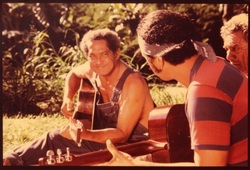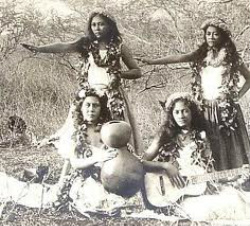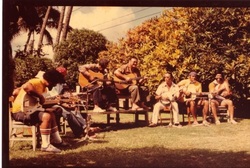
The choral nature of Hawaiian music is derived from its origins in chant, hula and drumming, a calling out for connection to the ancestors and the spirits of the natural world. When ships and people began to arrive on Hawaiian shores, the influences they brought were assimilated into the culture. From the hymns of the missionaries the Hawaiians acquired harmonics and melodies. The Portuguese, Mexicans, Spanish brought their guitars and after a long day of labor made music into the night. Island musical traditions also reflect the notion of ‘ohana, working together to create. In Hawaiian music, can be heard the stories from the ‘aina, of place and the people connected to those places. In this way, Hawaiian culture is preserved and understood, and so it’s no surprise that Gabby “Pops” Pahinui became an icon for the 1970’s Hawaiian Cultural Renaissance.
Gabby Pahinui grew up in Kaka’ako when it was a close knit village with ethnic clusters of residents, small stores, schools and parks. He learned to play by listening to and watching musicians playing in backyard kanikapila and for luau. As he developed musically he found himself straddling the grass roots world of Hawaiian music and the commercialized entertainment world, but his musical home was always kanikapila; his Waimanalo home, tucked in at the base of the Ko’olaus, hosted a nonstop flow of musicians who jammed into the night, notes twined together, leaping over the Ko'olaus, across the ocean, calling the spirits of the ancestors.


 RSS Feed
RSS Feed
